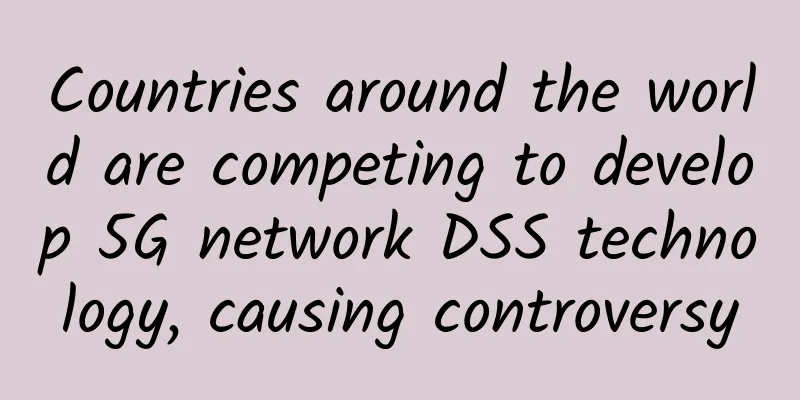Countries around the world are competing to develop 5G network DSS technology, causing controversy

|
After the 5G standards were frozen, the global industrial chain began to plan 5G construction, and operators in various countries began to compete to develop 5G, but the specific development progress and ideas were different.
Countries are racing to develop 5G The United States is actively building public 5G networks. For example, T-Mobile used the 600MHz spectrum and launched the first national 5G network in the United States in December 2019. In terms of network coverage, it is currently in operation in 49 states and Puerto Rico, and will soon be launched in more cities. AT&T announced on July 23 that its 5G network is now operating nationwide. The network began testing in major cities in the United States in 2017 and began to be launched commercially. This is another company that has deployed a 5G network nationwide after T-Mobile. AT&T has now added 40 new markets that support 5G, covering 395 markets in the United States and more than 205 million customers. AT&T is deploying 5G using both sub-6GHz (which AT&T calls 5G) and millimeter wave (which AT&T calls "5G+") technologies, the latter of which is only available in some markets in the United States. Verizon announced on June 22, 2020 that it had recently completed a dynamic spectrum sharing (DSS) trial in Texas and Minnesota. The trial, conducted in a live network environment, showed that LTE and 5G NR services operated simultaneously in low-frequency bands, and data sessions were completed effectively, with the goal of launching 5G nationwide in 2020. According to media reports on July 28, 2020, Deutsche Telekom said in terms of 5G deployment that it had achieved its goal of covering half of Germany's population in 2020 ahead of schedule, and now plans to achieve 5G coverage of 2/3 of Germany's population by the end of the year. Japan is also vigorously developing 5G. According to data released by Japan's Yano Research Institute on June 23, 2020, by fiscal 2020, the cumulative number of 5G service contracts of NTT docomo, KDDI, SoftBank and Rakuten will be 11.85 million, and domestic 5G smartphone shipments (based on manufacturer shipments) will be 13.33 million. However, as Japan's largest mobile company, NTT docomo announced in its performance announcement that as of August 1, 2020, the number of its 5G contracts was only 240,000, which shows that the development of 5G users in Japan is not satisfactory. The 5G frequency bands allocated by the Ministry of Internal Affairs and Communications to various mobile companies are 3.7GHz, 4.5GHz and 28GHz. The signal transmission distance is not far, and the number of base stations required is very large. Faced with this severe situation, the Japanese government is very anxious. To solve this problem, the Ministry of Internal Affairs and Communications announced a new goal in June 2020 to increase the number of 5G base stations established by mobile operators to more than 210,000 by the end of fiscal 2020, three times the initial plan. The way to achieve this goal is to fully adopt the "DSS" technology. If the frequency bands used in the existing 4G are converted to 5G sharing, it will be easy for mobile companies to obtain 5G base stations and the 5G area can be expanded immediately. In order to reverse the backward situation of 5G, the Japanese government regards DSS technology as a life-saving straw and wants to use DDS to quickly increase 5G national coverage in order to reverse the backward situation. How effective this approach is still needs to be tested in practice. In terms of 5G network deployment, Japan also realizes that it is lagging behind. Dedicated 5G networks gain favor In addition to the public 5G network under construction, local 5G and private 5G have also emerged. These two networks can be called dedicated 5G networks. Because 5G uses a very high frequency, the transmission distance is limited, and the signal is easily blocked by obstacles, it is difficult to cover a large area. Factories, enterprises, schools, government agencies, and urban areas are places where 5G is very needed. In such a small area, 5G signal coverage is relatively easy, so dedicated 5G networks came into being. Harbor Research, a US research company, predicts that by 2028, local 5G will make the IoT (Internet of Things) market reach $356 billion. There is not much difference between local 5G and private 5G from a technical point of view. The frequency used by local 5G is applied for by the undertaker, and the 5G facilities are purchased by the undertaker. The network construction, operation, use and maintenance are also the responsibility of the undertaker. For private 5G, the procurement, construction, operation and maintenance of network equipment are all the responsibility of mobile companies, and they are leased to factories and other units for use. Since private 5G is a network dedicated to factories and a customized exclusive network with visible services, data will not be transmitted through the public 5G network, so there are no external factors such as communication congestion, and it is easy to ensure security. In addition, mobile industry companies can provide customized core networks for factories through network slicing technology. The industry has now reached a consensus that "4G changes life, 5G changes society" and "80% of 5G will be used in the field of industrial Internet". Obviously, the application scenarios of 5G should be mainly industrial. Although 5G applications are still mostly experimental and mainly for individual users since the commercialization of 5G, the situation in Europe has changed recently. On June 25, 2020, American auto giant Ford Motor announced that it had signed a contract with Vodafone to introduce a private 5G network at its Essex electric vehicle battery plant in the UK. According to a joint statement from the two companies, the project is part of a £65 million 5G investment plan supported by the UK government. The private 5G network at the Ford plant will replace the existing Wi-Fi network to accelerate the production of electric vehicle parts. In recent years, the use of wireless networks in German factories started with Wi-Fi networks. Because it transmits a large amount of data and does not require communication fees, it has been widely used. However, its signal is unstable and its security is poor, so it is worrying to use it in key areas. Later, German factories introduced dedicated LTE to solve people's concerns, but with the development of smart manufacturing, LTE is difficult to meet the factory's requirements for bandwidth, latency, and speed compared to 5G, and this is when dedicated 5G comes in handy. The application of wireless networks in the German manufacturing industry can be said to be a continuous development process from private LTE to local 5G. Factory automation is underway, and it is necessary to have robotic arms and self-propelled robots with real-time wireless control in order to improve productivity and ensure quality. In order to achieve these goals, dedicated LTE is being gradually introduced, but based on the scale of the factory and the complexity of the production process, from existing experience, LTE is not enough to support it, so dedicated 5G is a must. In addition, various data obtained from the manufacturing process will be deployed on edge terminals or the cloud through private 5G networks, collected in real time and processed by AI (artificial intelligence), so automation is easy. In terms of local 5G, some factories, enterprises and other units in Germany have obtained authorization to use 5G frequency bands, which will play an important role in enhancing the capabilities of Germany's smart manufacturing industry. Japan is also a manufacturing powerhouse. In order to promote the development of industry towards intelligent manufacturing, Japan also attaches great importance to the development of dedicated 5G. The Ministry of Internal Affairs and Communications of Japan has formulated a frequency plan and allocated a dedicated frequency band for dedicated 5G. The "Local 5G Research Working Group" of the Information and Communications Commission of Japan is also studying "local 5G" which is "using 5G to build a relatively small-scale communication system based on local needs". The Ministry of Internal Affairs and Communications of Japan has formulated a 5G frequency plan and stipulated the use frequency of local 5G, see figure. Figure 5G frequency division in Japan Japanese enterprises and mobile companies have also begun to pay attention to dedicated 5G. For example, Toyota Production Engineering recently selected Nokia to install an industrial-grade dedicated 5G network in its manufacturing design center. On May 20, 2020, SoftBank announced that it will provide "private 5G" services starting in 2022, using the 5G frequency bands allocated to SoftBank and providing 5G network services to enterprises that need to use 5G networks in limited areas (such as local areas), while being responsible for the construction and operation of the network. Why is SoftBank setting out to build a public 5G network nationwide while also offering network services such as private 5G? This is because the 5G frequencies allocated to SoftBank are very high, and due to interference from domestic satellite communications in Japan, it is difficult to set up base stations and expand the coverage area. SoftBank's 5G deployment rate in 5 years using the allocated 5G bands is only 64%, much lower than NTT docomo or KDDI. Therefore, SoftBank has shown a great interest in private 5G. If the 5G bands are used in buildings in specific places that are not affected by satellite communications, many of the above problems can be easily solved. Therefore, by providing enterprises with 5G networks in limited locations, 5G frequency bands can be effectively used for commercial services and to attract high-quality customers. Since SoftBank's 5G network will be operational in the second half of 2021, the provision of private 5G will be around 2022. Since SoftBank's private 5G can be used nationwide, this can achieve service diversity by linking with public 5G, connecting and billing data inside and outside private 5G. Of course, there are also challenges in providing private 5G. It is not yet known whether SoftBank will allocate dedicated frequencies for private 5G. If dedicated frequencies are allocated, the number of frequencies that public 5G can use will be reduced accordingly. Therefore, people are concerned about whether this will affect 5G capacity. If the same frequency is used, it may be interfered with by adjacent 5G base stations. DSS technology sparks controversy DSS technology is a good choice as a supplement and auxiliary to 5G networks. It has many advantages, but using it as a supporting technology for 5G networks has caused a lot of controversy around the world, with some supporting it and others questioning it. The attitudes of major mobile operators in the United States and Japan are completely different when it comes to DSS technology. Some operators are very positive about deploying DSS due to the lack of 5G frequencies and have included it in their engineering plans. This is represented by Japan's SoftBank and the United States' Verizon and AT&T. Some companies are more cautious and have some concerns even though they have prepared engineering arrangements, such as KDDI. In addition, NTT docomo and T-Mobile in the United States have no plans for DSS technology because they have no problem with 5G frequency resources. NTT docomo believes that 5G supported by DSS technology cannot meet the real 5G indicators in terms of bandwidth and speed, so it is not real 5G, but fake 5G. |
<<: Why are unlimited data plans dying?
>>: Wi-Fi 6 Development Status and Future Application Trends
Recommend
Maxthon Host Los Angeles Unicom AS9929 Line VPS Simple Test
Yesterday I shared the news about Maxthon's L...
Operators' operating data in April: 5G package users increased by 21.16 million, totaling about 870 million
The three major operators released their operatin...
The Changing Data Center: The Impact of Network Costs
As data center infrastructure adopts artificial i...
Anynode: $15/year KVM-1GB/20G SSD/2TB/Las Vegas
The last time I shared information about Anynode ...
5G network frequency band allocation is in turmoil again. Will the country allow spectrum resource auctions?
The recently revised "Radio Management Regul...
The difficulty of operation and maintenance has reached a new level - it does not exist!
What is the data center most afraid of? Power out...
Good news! Deepin Technology won the title of "National Intellectual Property Demonstration Enterprise"
Recently, the National Intellectual Property Admi...
How is the VoLTE development of the three major operators?
There are always various opportunities for indust...
The arrival of the fourth largest operator, what can it change?
On October 12, China Broadcasting Network Co., Lt...
API Gateway: Layer 8 Network
An API is a set of rules that govern the exchange...
"Innovation City" shines brightly and opens up a new ecosystem for Ascend
[[337542]] On August 11, 2020, the DevRun Develop...
2021 Information and Communication Industry Events
ICT industry recovers According to statistics fro...
Is Graph Data Science the Secret to Accelerating Machine Learning?
In the past decade, the field of machine learning...
6 ways to remove duplicate URLs! (with detailed code)
[[341325]] This article is reprinted from the WeC...
Now is the time to use 5G indoors
Operators have made huge investments in 5G RAN, w...









